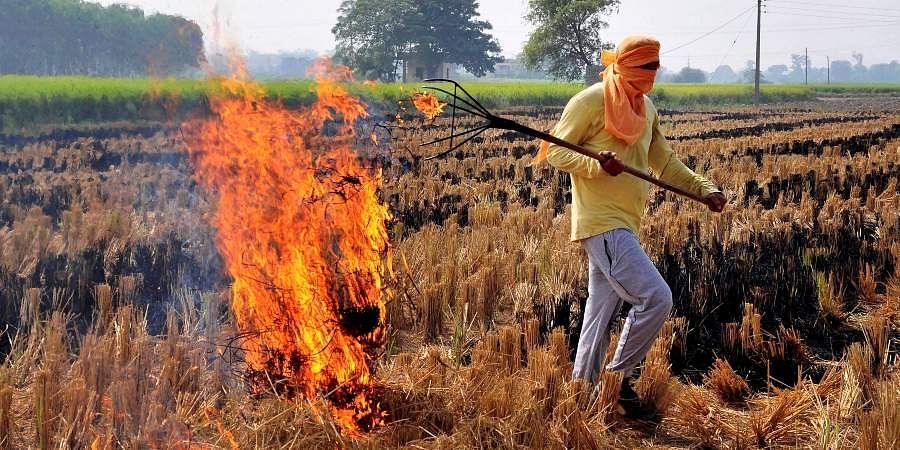Despite state subsidy of millions of rupees and offers of crop residue management machines, Punjab farmers continue to set their fields on fire. Cultivators said they were forced to burn the crop residue, reported Gaon Connection. The report said super-seeder and happy seeder machines cost Rs2.5 lakh. Even if farmers take it on rent, they require a 55 hp (horsepower) tractor to run it, but most of them have a 35 hp one, which can’t be used to run these machines to tackle crop residue.
According to Punjab Remote Sensing Centre, Ludhiana, on November 10, Punjab had recorded a total of 55,573 cases of farm fires so far this year. Of these, 4,156 fire counts were recorded on that day itself and Sangrur’s contribution was the highest—566 (about 14%). According to SAFAR (System of Air Quality and Weather Forecasting and Research) developed by the Indian Institute of Tropical Meteorology (IITM) Pune, on November 7, the contribution of stubble burning to Delhi air pollution (PM2.5) stood at 48%, which dropped to 26% on November 12.
Delhi’s air quality to remain “very poor” this week
Air quality won’t improve over the next three days, said the central government forecasting agency SAFAR on Monday. The transport-level wind speed is increasing, resulting in more intrusion of stubble burning-related pollutants into Delhi. On Monday, Delhi’s 24-hour average air quality index stood at 353 at 4pm. The agency predicted that the air quality will remain in the higher end of the very poor category.
Meanwhile, the Supreme Court, in its hearing of the Delhi pollution crisis asked for the reconsideration of the work-from-home policy. The Centre told the top court that stubble burning contributes to only 10% of the Capital’s dirty air. This comes as the Delhi government told the Apex court that it is ready to take steps such as “complete lockdown to control local emissions”. The top court rapped the Delhi government for solely focusing stubble-burning as the cause of pollution in its affidavit. The SC has called for the shut down of six thermal power plants in the national capital region as an emergency measure to deal with the worsening air quality situation.
Experts have recommended N-95 masks in Delhi and schools and colleges have been shut because of “very poor” air quality.
4 new pollution sites emerge, Delhi now has 17 pollution hotspots
In the first week of November, four new pollution hotspots emerged in Delhi in the joint finding of the Central Pollution Control Board and Delhi Pollution Control Board. The new locations that recorded alarmingly high levels of pollution included ITO, Sonia Vihar, Alipur and Nehru Nagar.
Delhi’s 13 original pollution hot spots—identified first in 2018 for area-specific action, continue to record alarmingly high levels of pollution, data shows. Delhi’s original 13 hot spots were Jahangirpuri, Anand Vihar, Ashok Vihar, Wazirpur, Punjabi Bagh, Dwarka Sector 8, Rohini Sector 16, RK Puram, Bawana, Mundka, Narela, Okhla Phase II and Vivek Vihar. While locations such as Bawana, Mundka, Narela, Jahangirpuri and Wazirpur, Okhla-Phase II are largely dominated by industries, residential hotspots such as Dwarka’s sector 8, Rohini’s sector-16 and Punjabi Bagh have different sources of pollution. RK Puram and Anand Vihar are polluted mostly because of heavy traffic movement around them. Action can be taken only if agencies know specific sources of pollution in the areas experts said.
Humidity, low wind speed & traffic: Mumbai’s Colaba records air quality worse than Delhi
Mumbai’s southernmost point Colaba recorded an air quality index of 345 on Monday which experts said was worse than even Delhi’s (AQI 331) at a time when the capital is reeling under the worst air pollution. According to the System of Air Quality and Weather Forecasting And Research (SAFAR). Experts blamed the “lethal combination” of pollution and humidity on vehicular traffic and smaller ships as well.
Dr Gufran Beig, founder and project director of Safar told TOI that natural factors such as low temperature, low wind speed and high humidity had combined to keep more particulate matter suspended in air over Colaba, resulting in their concentration at higher levels.
About The Author
You may also like
Firecrackers caused pollution to spike three-fold this Diwali: Report
Bengaluru, Mumbai, Patna With the Highest PM2.5 Emissions From Diesel Generators: Study
Hyperlocal air quality monitoring identifies pollution hotspots in Indian cities: Study
Meat, dairy industry surpasses fossil fuels in methane emissions: Report
Delhi-NCR most polluted region in India, Karnataka the cleanest air in India: Report

